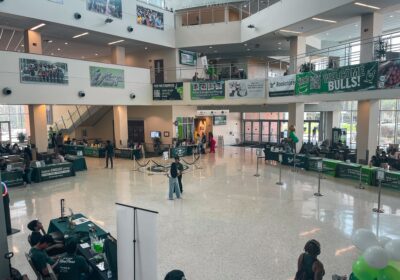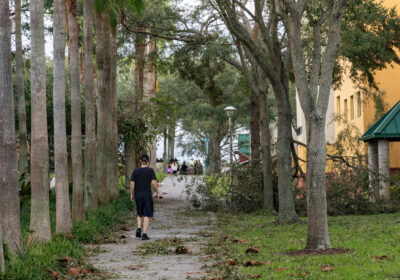Holocaust survivor speaks at USF: ‘I never lost faith’

Joseph Alexander said he had a “very good life” with his family until Nazi Germany’s invasion of Poland in 1939.
He was only 17 years old the first time he was in a concentration camp.
Alexander survived 12 camps, including Auschwitz and Dachau, and is the only survivor of his immediate family, which included his parents, three sisters and two brothers.
He shared his story with students at an event organized by Chabad at USF last Thursday.
Related: USF Hillel introduces first Jewish Life Festival
Born in Kowal, Poland, the 102-year-old told his story in detail, from the moment he was forced to leave his hometown, taken to the ghetto and multiple concentration camps, before he finally arrived in the U.S.
The work at the first camp required him to be knee-deep in water with no boots on and eventually gave him sepsis, he said.
After six weeks of working there, Alexander went home with no intention of returning.
“One weekend, I said, ‘I’m not going back’,” he said.
After the first camp, Alexander and his family moved to the Warsaw ghetto, established by German authorities in 1940.
The Warsaw ghetto was a designated area that kept Jewish residents separated from the rest of the city’s residents.
Around 30% of the city’s population was packed into 2.4% of the city’s area, according to the United States Holocaust Memorial Museum.
“You can’t even imagine how terrible, how bad it was,” he said. “After you walked out from the house in the morning, the dead people on the streets were everywhere.”

Alexander said his family had to pay the guard at the ghetto’s gates to leave and return to his hometown.
Related: Jewish spy shares stories of World War II
In his hometown, Alexander had three days of freedom before an order was given for all Jewish men from 16 to 60 years old to report to a “schoolhouse.” Then, he was sent to another concentration camp.
That was the last time he saw most of his family members.
He said he went through different camps where he worked on laying cobblestones on the street and building sewers and roofs, before being taken to Auschwitz.
“They put 34 people in one box car,” he said. “We were riding on for three days, no food, no water, no facilities. Between 30 and 40 percent of the people were dead on the train.”
Alexander said he avoided being selected by Josef Mengele upon arriving at Auschwitz.
Mengele, nicknamed the “angel of death,” was a physician who ran “inhumane and often deadly” medical experiments on prisoners at Auschwitz, according to the United States Holocaust Memorial Museum. He also conducted “selections” of people who would be sent to the gas chambers.
Alexander said Mengele separated the prisoners in two lines — one to the right and the other to the left.
Because he had been in other camps, Alexander said he knew the line to the left meant death, so he ran to the other side when Mengele looked away.
Near the end of World War II, he went through one of the death marches organized by Nazis, in which he and other prisoners walked through German mountains.
After two days, American troops found them and liberated the group.
Related: Sylvie Feinsmith strives to create a safe place for Jewish students
The American troops then moved the group to a “displaced persons” camp, which Alexander said was an opportunity for survivors to find their families if they had also survived.
However, Alexander never found out what happened to his family after he left the ghetto.
He said he lived in Germany for four years after being liberated.
He arrived in New York in 1949 and moved to Los Angeles a year later to be with an uncle and cousin who also survived.
Alexander still lives in Los Angeles but spends most of his time telling his story around the country.
“I never lost faith,” he said. “I never stopped believing in God. And I said, ‘I may have a bad day today, but I hope tomorrow will be a better day.’”







